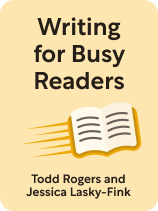

This article is an excerpt from the Shortform book guide to "Writing for Busy Readers" by Todd Rogers and Jessica Lasky-Fink. Shortform has the world's best summaries and analyses of books you should be reading.
Like this article? Sign up for a free trial here.
Do you struggle to stay on track with your writing? How can you align your goals with your readers’ goals?
Behavioral scientists Todd Rogers and Jessica Lasky-Fink write in their book Writing for Busy Readers that in order for your writing to make an impact, you have to write with purpose. To write with purpose, you must identify your goals and your readers’ goals.
Keep reading to learn how to instill purpose into your messages.
Refine Your Purpose
Effective writing is purposeful—you want to convey a specific idea and have a particular impact on readers. To achieve this, Rogers and Lasky-Fink say you must refine your purpose by identifying your goals and aligning them with your readers’ goals. Let’s explore how to write with purpose in greater detail.
Identify Your Goal
To refine your purpose, first identify the goal of your content. According to Rogers and Lasky-Fink, you should ask yourself what key takeaway you want readers to understand, even if they only spend a few moments distractedly skimming your writing. Your goal is to communicate this takeaway as clearly as possible.
Rogers and Lasky-Fink note that there may be more than one takeaway, but your writing should still be pointed. For example, say you’re writing a project update for your team. A pointed message might focus on two related takeaways, such as “We’ve met our deadlines so far, but we need additional input on the marketing plan to stay on track.” If you also want to share details about an upcoming team-building event (an unrelated takeaway), you might put that information in a separate email to maintain clarity and avoid diluting your primary messages.
If you’re not sure what your goals are from the outset, start writing anyway—the authors explain that writing helps you organize your thoughts, and your first draft may illuminate the most valuable takeaways.
| How to Identify Your Writing Goal When you know you need to write something but aren’t sure what your purpose is, don’t panic—uncertainty is part of the process. Other experts agree with Rogers and Lasky-Fink that your writing goal emerges more clearly as you begin drafting. For example, journalist Joan Didion once explained that for her, writing was a discovery process that revealed what she thought only after she began putting words on the page. To identify your writing goal faster, try these strategies: 1) Distinguish your topic from your angle. Your topic is the general subject you’re writing about, like “remote work” or “home decorating.” Your angle is the specific perspective or insight you want to share—for example, “why our team is more productive working remotely.” Identifying your angle helps you focus your message on your takeaway. 2) Craft a working thesis statement. You probably remember thesis statements from your high school English classes. Thesis statements encapsulate your main idea—the takeaway you want readers to remember, even if you’re only skimming. If you have more than one takeaway, writing a thesis statement can help you decide whether they belong in the same piece of writing. Try expressing both takeaways in a single sentence; if the result feels cohesive and focused, they likely work together. But if the sentence feels clunky, that’s a signal you should split your message into two pieces of writing. |
Align Your Goals With the Reader’s Goals
Second, refining your purpose requires that you align your goals with your readers’ goals. Rogers and Lasky-Fink explain that if you fail to address what matters most to your audience, readers will ignore or misunderstand your content, and you won’t be able to achieve your purpose. To bridge this gap, you must emphasize why the content matters and is relevant to your specific audience.
For example, if you’re writing a petition about a climate change initiative, you could focus on a specific, relatable takeaway: “Support this initiative to reduce carbon emissions—it will lower local air pollution and protect your community’s health.” By stressing how your goals align with your readers’ goal of maintaining their community’s health, you make your content more engaging, relevant, and actionable.
Other factors to consider are your readers’ biases. Studies show that writers of marginalized identities may face greater skepticism from certain readers, which makes it more difficult for those writers to connect with their audiences. Rogers and Lasky-Fink acknowledge that although it’s unfair, the burden is on the writer to establish credibility and overcome the readers’ biases.
For example, if your target audience is older adults who may perceive younger writers as brash or entitled, then to counter this bias as a young writer, you might adopt a respectful and measured tone and demonstrate empathy for your readers’ perspectives. This approach helps readers believe you’re working toward shared interests, making them more likely to engage with your message.
| How to Know Your Audience Rogers and Lasky-Fink argue that effective writing doesn’t just clarify what you want to say; it also considers what your readers need to hear and what their biases might be. But how do you find these things out? Many professional writers, including journalists, marketers, and public health communicators, conduct formal research to learn more about their audiences. Thankfully, you don’t need a research team to do the same. Try these practical strategies for getting to know your audience: 1. Talk to people like your readers: Ask colleagues, clients, or peers who resemble your target audience what they care about and what kinds of messages persuade or alienate them. 2. Put yourself in your readers’ shoes: Imagine their backgrounds, the pressures they face, and their goals. How would these factors shape how they receive your content? What can you emphasize in your writing to pique their interest? 3. Look at what already works: If you’re writing for a specific workplace, community, or publication, study past communications that got strong engagement. What tone did they use? How did they make the content seem relevant to readers? Taking these steps helps you empathize with your audience; in turn, this can help you identify and strategize around your readers’ biases. Rogers and Lasky-Fink note that marginalized people often face greater skepticism from certain audiences, a phenomenon philosopher Miranda Fricker calls “testimonial injustice.” On the flip side, sometimes writers with more social privilege are dismissed by readers from marginalized communities. In either case, Rogers and Lasky-Fink suggest that the onus is on you, as the writer, to proactively establish your credibility. One study suggests that transparency can accomplish this. When officials tried to promote vaccines during the Covid-19 pandemic, they had trouble reaching some Black Americans who distrusted medical institutions due to a long history of medical racism. By addressing the roots of this distrust and being transparent about safeguards against unethical treatment, communicators were better able to build credibility and connect with skeptical audiences. |

———End of Preview———
Like what you just read? Read the rest of the world's best book summary and analysis of Todd Rogers and Jessica Lasky-Fink's "Writing for Busy Readers" at Shortform.
Here's what you'll find in our full Writing for Busy Readers summary:
- Why some writers are so successful at connecting with readers while others aren't
- How to make your writing more impactful and increase your reach
- That how you communicate can be just as important as what you say






